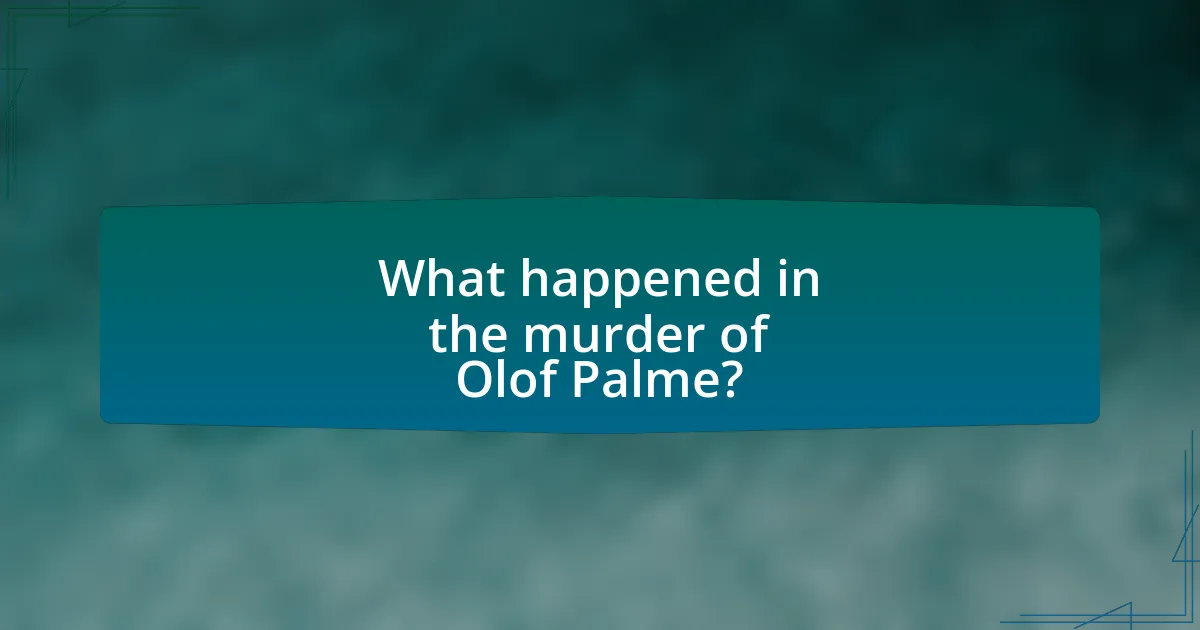The article focuses on the unsolved murder of Olof Palme, the Prime Minister of Sweden, who was assassinated on February 28, 1986, while walking home from the cinema in Stockholm. It explores Palme’s significance in Swedish politics, his progressive policies, and the political climate surrounding his assassination, which remains one of the most notorious unsolved cases in modern history. The article details the extensive investigations that followed, the various theories regarding motives—including political retribution and organized crime—and the lasting political implications of his murder on public trust and government institutions in Sweden. Additionally, it examines the role of media in shaping public perception and discusses lessons learned from the case, including the importance of transparency and security measures for political figures.

What happened in the murder of Olof Palme?
Olof Palme, the Prime Minister of Sweden, was murdered on February 28, 1986, while walking home from the cinema with his wife in Stockholm. He was shot in the back by an unknown assailant, leading to a lengthy investigation that spanned decades. Despite numerous theories and suspects, including a potential connection to political motives or organized crime, the case remained unsolved for many years. In June 2020, Swedish authorities announced that they believed a man named Stig Engström, who had died in 2000, was the likely perpetrator, but no definitive proof was established to conclusively close the case.
Who was Olof Palme and why was he significant?
Olof Palme was the Prime Minister of Sweden, serving from 1969 until his assassination in 1986. He was significant for his progressive policies, including social welfare reforms and a strong stance on international issues, such as anti-colonialism and nuclear disarmament. Palme’s leadership positioned Sweden as a prominent voice in global politics, advocating for peace and social justice. His assassination on February 28, 1986, in Stockholm remains one of the most notorious unsolved murders in modern history, leading to extensive investigations and numerous conspiracy theories, which have had lasting political implications in Sweden and beyond.
What were Olof Palme’s contributions to Swedish politics?
Olof Palme significantly shaped Swedish politics through his leadership as Prime Minister and his advocacy for social democracy. He served as Prime Minister from 1969 to 1976 and again from 1982 until his assassination in 1986, during which he implemented policies that expanded the welfare state, promoted gender equality, and advanced labor rights. Palme’s government also emphasized Sweden’s role in international diplomacy, particularly in promoting peace and disarmament, which positioned Sweden as a mediator in global conflicts. His commitment to a mixed economy and progressive taxation helped reduce income inequality in Sweden, reinforcing the country’s social democratic values.
How did Palme’s political stance influence his assassination?
Olof Palme’s political stance, characterized by his advocacy for social democracy and opposition to the Vietnam War, significantly influenced his assassination. His progressive policies and outspoken criticism of both domestic and international issues, including his support for anti-colonial movements, created numerous political enemies. For instance, Palme’s alignment with leftist ideologies and his efforts to promote Sweden as a neutral mediator in global conflicts led to tensions with various political factions, including right-wing groups. This animosity is evidenced by the fact that his assassination occurred during a period of heightened political polarization in Sweden, where his policies were met with fierce opposition from conservative elements.
What are the key events surrounding the murder?
The key events surrounding the murder of Olof Palme include his assassination on February 28, 1986, while walking home from the cinema in Stockholm with his wife. Shortly after the shooting, witnesses reported seeing a man fleeing the scene, which initiated a massive police investigation. The investigation faced numerous challenges, including a lack of physical evidence and conflicting witness testimonies. In 1989, a suspect named Christer Pettersson was convicted but later acquitted on appeal due to insufficient evidence. Over the years, various theories emerged regarding the motives behind the murder, including political implications tied to Palme’s stance on international issues. In June 2020, Swedish authorities announced that they believed Stig Engström, a man present at the scene, was the likely perpetrator, but he had died in 2000, leaving the case officially unresolved.
When and where did the murder take place?
The murder of Olof Palme took place on February 28, 1986, in Stockholm, Sweden. Palme was shot while walking home from the cinema with his wife, Lisbet Palme, near Sveavägen. This incident is significant as it remains one of Sweden’s most notorious unsolved cases, leading to various political implications and theories surrounding the event.
What were the immediate reactions to Palme’s assassination?
The immediate reactions to Olof Palme’s assassination included shock and disbelief across Sweden and internationally. Swedish citizens expressed profound grief, with many gathering in public spaces to mourn and pay tribute. Political leaders, both domestically and abroad, condemned the act, emphasizing the threat it posed to democracy and stability. The Swedish government initiated an extensive investigation, while media coverage highlighted the potential implications for national security and political discourse. These reactions underscored the significance of Palme’s role as a prominent political figure and the impact of his assassination on Swedish society and politics.
What investigations have been conducted into the murder?
Multiple investigations have been conducted into the murder of Olof Palme, the Swedish Prime Minister, who was assassinated on February 28, 1986. The initial investigation involved extensive police work, including witness interviews and forensic analysis, but it faced challenges due to a lack of concrete evidence. Over the years, various theories emerged, leading to several re-investigations, including a significant one in 1996 that focused on a suspect named Christer Pettersson, who was convicted but later acquitted on appeal. In 2020, the Swedish authorities announced that they had identified a new suspect, Stig Engström, also known as the Skandia Man, who had died in 2000, marking a pivotal moment in the long-standing case. This conclusion was based on a comprehensive review of evidence, including witness testimonies and forensic data, which pointed towards Engström’s involvement.
How did the police investigation unfold over the years?
The police investigation into the murder of Olof Palme unfolded over several decades, marked by numerous leads, suspects, and shifts in focus. Initially, the investigation began immediately after Palme was shot on February 28, 1986, with extensive efforts to gather evidence and witness testimonies. Over the years, the investigation faced challenges, including a lack of concrete evidence and the emergence of various theories regarding the motive and identity of the killer.
In 1996, a significant development occurred when a man named Christer Pettersson was convicted of the murder, but this conviction was later overturned due to insufficient evidence. The investigation continued to evolve, with the police exploring connections to political motives, organized crime, and even foreign involvement. In 2018, the Swedish police announced they had identified a new suspect, Stig Engström, who had died in 2000, leading to renewed discussions about the case’s resolution.
Throughout the years, the investigation has been characterized by its complexity and the ongoing public interest, reflecting the political implications surrounding Palme’s assassination and the challenges of solving high-profile murders.
What role did media play in shaping public perception of the case?
Media played a crucial role in shaping public perception of the Olof Palme murder case by influencing narratives and framing the investigation. Extensive coverage by newspapers and television highlighted various theories and suspects, which led to public speculation and debate. For instance, sensationalist reporting often emphasized conspiracy theories, which contributed to a climate of mistrust towards authorities and the police investigation. This was evident in the way media outlets reported on the lack of progress in solving the case, which fueled frustration among the public and led to widespread calls for accountability. Additionally, the portrayal of key figures involved in the case, including politicians and law enforcement, shaped how the public viewed their credibility and competence. Overall, the media’s framing and emphasis on certain aspects of the case significantly influenced public opinion and understanding of the ongoing investigation.
What are the political implications of Palme’s murder?
The political implications of Olof Palme’s murder include a significant destabilization of Sweden’s political landscape and a long-lasting impact on public trust in government institutions. Palme, as Prime Minister, was a prominent figure advocating for social democracy and international peace, and his assassination in 1986 led to heightened political tensions and conspiracy theories that questioned the integrity of the Swedish political system. The unresolved nature of the case fostered a climate of uncertainty and speculation, which affected political discourse and policy-making in Sweden for decades. Furthermore, the murder prompted discussions about security and the role of political leaders, influencing subsequent elections and the public’s perception of political safety and accountability.
How did the assassination impact Swedish politics?
The assassination of Olof Palme significantly impacted Swedish politics by creating a climate of political instability and distrust in the government. Following Palme’s murder in 1986, there was a surge in public concern regarding political safety and the effectiveness of law enforcement, leading to increased scrutiny of the Swedish political system. The unresolved nature of the case fostered conspiracy theories and speculation, which undermined public confidence in the authorities. Additionally, the assassination shifted political discourse, prompting debates on security policies and the role of the state in protecting its citizens, ultimately influencing subsequent elections and party dynamics in Sweden.
What changes occurred in political leadership following the murder?
Following the murder of Olof Palme in 1986, significant changes occurred in Swedish political leadership, including a shift in party dynamics and leadership roles. The Social Democratic Party, which Palme led, faced internal challenges and a decline in public support, leading to the resignation of several key figures and a reevaluation of party strategies. Subsequently, in the 1991 elections, the center-right coalition, known as the Alliance, gained power, marking a notable shift in governance. This transition reflected a broader political realignment in Sweden, as the murder intensified discussions around security and political accountability, influencing future electoral outcomes and party policies.
How did the murder affect public trust in government institutions?
The murder of Olof Palme significantly eroded public trust in government institutions in Sweden. Following the assassination in 1986, widespread speculation and conspiracy theories emerged, leading citizens to question the effectiveness and transparency of law enforcement and political leadership. A 2016 survey indicated that only 30% of Swedes believed the police were capable of solving the case, reflecting a deep-seated skepticism towards governmental authority. This decline in trust was further exacerbated by perceived failures in the investigation, including mishandling of evidence and lack of accountability, which fueled public disillusionment with the institutions meant to uphold justice and security.
What theories have emerged regarding the motives behind the murder?
Theories regarding the motives behind the murder of Olof Palme include political retribution, personal vendetta, and organized crime involvement. Political retribution is suggested due to Palme’s controversial stances on issues such as apartheid and his support for various liberation movements, which may have angered political adversaries. A personal vendetta theory posits that Palme had enemies from his political career who sought revenge. Additionally, some theories propose that organized crime may have been involved, possibly linked to Palme’s anti-drug policies that threatened criminal enterprises. These theories are supported by various investigations and analyses conducted over the years, highlighting the complex political landscape of Sweden during Palme’s tenure.
What are the most prominent conspiracy theories related to Palme’s assassination?
The most prominent conspiracy theories related to Olof Palme’s assassination include the involvement of the Swedish security services, a foreign intelligence agency, and organized crime. One theory suggests that Palme was killed due to his opposition to the apartheid regime in South Africa, with claims that the South African government orchestrated the assassination. Another theory posits that the assassination was a result of internal political conflicts, implicating rival political factions within Sweden. Additionally, some theories propose that Palme’s murder was linked to the Kurdish separatist movement, suggesting that he was targeted for his support of Kurdish rights. These theories have persisted due to the lack of conclusive evidence and the controversial nature of Palme’s political stance, which made him a target for various groups.
How do these theories reflect the political climate of the time?
The theories surrounding the unsolved murder of Olof Palme reflect the political climate of the time by illustrating the deep-seated tensions and divisions within Swedish society during the 1980s. Theories such as state involvement or conspiracy highlight the public’s distrust in government institutions, fueled by political scandals and a growing sense of disillusionment with authority. For instance, the rise of leftist movements and the Cold War context contributed to suspicions regarding political motives behind Palme’s assassination, as he was a prominent figure advocating for social democracy and international peace. This distrust was further exacerbated by the lack of transparency in the investigation, leading to widespread speculation and conspiracy theories that mirrored the societal anxieties of the era.

What lessons can be learned from the unsolved case of Olof Palme?
The unsolved case of Olof Palme teaches the importance of thorough investigative processes and the need for transparency in law enforcement. The prolonged uncertainty surrounding Palme’s assassination, which occurred in 1986, highlights how inadequate initial investigations can lead to lasting public distrust. Despite numerous theories and suspects, including political motives and organized crime, the lack of conclusive evidence has resulted in a failure to bring justice, emphasizing the necessity for robust forensic methods and inter-agency cooperation in high-profile cases. This case also illustrates the potential political ramifications of unresolved murders, as it can lead to speculation and conspiracy theories that undermine public confidence in governmental institutions.
What can be done to prevent similar political assassinations?
To prevent similar political assassinations, governments should implement comprehensive security measures for public officials, including enhanced threat assessments and protective details. Historical instances, such as the assassination of Olof Palme in 1986, highlight the need for improved intelligence sharing and collaboration among law enforcement agencies to identify and mitigate potential threats. Additionally, fostering a political culture that discourages violence through public education and community engagement can reduce the likelihood of such acts. Studies indicate that countries with robust political discourse and civic participation experience fewer political assassinations, reinforcing the importance of a healthy democratic environment.
How can governments enhance the protection of political figures?
Governments can enhance the protection of political figures by implementing comprehensive security measures, including increased surveillance, specialized training for security personnel, and the use of advanced technology. For instance, countries like Sweden have adopted enhanced security protocols following high-profile assassinations, such as that of Olof Palme, which involved a lack of adequate protection at the time. By investing in real-time monitoring systems and employing risk assessment strategies, governments can better anticipate threats and respond effectively, thereby reducing the likelihood of attacks on political figures.
What role does public engagement play in political safety?
Public engagement plays a crucial role in political safety by fostering transparency, accountability, and trust between citizens and their government. When the public actively participates in political processes, it creates a system of checks and balances that can deter corruption and abuse of power. For instance, in the aftermath of Olof Palme’s murder, public engagement through protests and discussions highlighted the demand for justice and transparency, which pressured authorities to investigate thoroughly. This collective action can lead to a more informed electorate, ultimately contributing to a safer political environment by ensuring that leaders are held accountable for their actions.
What resources are available for further understanding the case?
Resources available for further understanding the case of Olof Palme’s unsolved murder include books, documentaries, and academic articles. Notable books such as “The Unsolved Murder of Olof Palme” by Lars Larsson provide detailed analyses of the events surrounding the case. Documentaries like “The Murder of Olof Palme” offer visual insights and expert interviews that explore various theories and political implications. Additionally, academic articles published in journals such as “Scandinavian Journal of History” analyze the case from historical and political perspectives, contributing to a deeper understanding of its complexities. These resources collectively enhance comprehension of the case’s significance in Swedish politics and society.
Where can one find comprehensive analyses of the Palme case?
Comprehensive analyses of the Palme case can be found in various academic journals, books, and dedicated websites focused on true crime and political history. Notable sources include the book “The Unsolved Murder of Olof Palme” by Lars Larsson, which provides an in-depth examination of the case, and articles published in journals such as “Scandinavian Journal of History,” which often explore the political implications surrounding the murder. Additionally, websites like the Swedish National Police’s official site and the Olof Palme Memorial Fund offer detailed reports and analyses related to the case, ensuring a thorough understanding of its complexities.
What are the best practices for studying unsolved political crimes?
The best practices for studying unsolved political crimes include thorough archival research, interdisciplinary collaboration, and the application of forensic methodologies. Archival research allows scholars to access historical documents, witness testimonies, and government records, which can provide critical insights into the context and circumstances surrounding the crime. Interdisciplinary collaboration, involving experts from fields such as law, sociology, and criminology, enhances the analytical framework and fosters diverse perspectives on the case. The application of forensic methodologies, including digital forensics and data analysis, can uncover new evidence or patterns that may have been overlooked. These practices are supported by the need for a comprehensive understanding of the socio-political environment in which the crime occurred, as demonstrated in studies of high-profile cases like the assassination of Olof Palme, where political implications and theories significantly influence the investigation.


